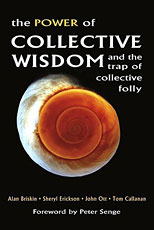The Collective Wisdom Initiative is an informal network of practitioners and scholars exploring an emerging field of study and practice called by its founding stewards collective wisdom. Initially funded through support from the Fetzer Institute in 2000, the CWI is based on the conviction that groups have the potential to be sources of extraordinary creative power, incubators of innovative ideas, and vehicles for social healing. During its initial years, the CWI was a leader in cultivating relationships across diverse disciplines, commissioning a series of groundbreaking writings, and interviewing thought leaders. The emphasis was on the active, dynamic nature of initiative. There was evidence of a compelling force that was motivating people to come together in meaningful and collective ways to address social needs and concerns. In 2002, a website www.collectivewisdominitiative.org was created to make visible this emerging field.
Tom Callanan and Sheryl Erickson, co-founders of the Collective Wisdom Initiative, along with Alan Briskin and John Ott, are convinced that when human beings gather in groups or communities and truly listen, share, and act in concert with one another, collective wisdom can arise and transform lives. Six stances engender this process:
• Deep Listening
• Suspension of Certainty
• Seeing Whole Systems / Seeking Diverse Perspectives
• Respect for Others / Group Discernment
• Welcoming All That Is Arising
• Trust in the Transcendent
This thought-provoking section is followed by stories of actions and beliefs (Paula Underwood, Jacob Needleman, Lauren Artress, Jeremy Sternin) conducive to collective wisdom. Next, the editors present five visionaries (Carl Jung, Albert Einstein, Pierre Teilhard de Chardin, Mary Parker Follett, and Ralph Waldo Emerson) who can serve as models for the pursuit of wisdom, connections, cocreative power, and fresh perspectives.
The shadow side of collective wisdom is collective folly and the suffering and pain that can arise from polarization in groups that spread hate, misunderstanding, exclusion, and violence. The editors explore this dimension and then turn to accounts of groups that have marshaled their collective energy to bring about healing, creativity, and resolution of conflict. Here collaboration is celebrated. The final chapter hurrahs four mindfulness practice which have proven to be spurs to collective wisdom.
